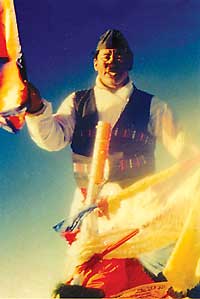 The Guinness Book of World Records should dedicate a separate chapter to the exploits on the world's highest peak. All the feats on Everest: first by south-east ridge, first by South Col, first by the north face, first by the south-west face (the hard way), first without oxygen, first alpine solo, first traverse, first woman, youngest, oldest, first downhiller, first handicapped, first internet millionaire or movie mogul, first paraglider, fastest, slowest.
The Guinness Book of World Records should dedicate a separate chapter to the exploits on the world's highest peak. All the feats on Everest: first by south-east ridge, first by South Col, first by the north face, first by the south-west face (the hard way), first without oxygen, first alpine solo, first traverse, first woman, youngest, oldest, first downhiller, first handicapped, first internet millionaire or movie mogul, first paraglider, fastest, slowest. This rat race for records along with traffic jams on the summit ridge has trivialised the noble pursuit of climbing. Or has it? This trend of breaking records is a sign of times and a reflection of the self-obsessed world of instant gratification that we live in. There are different breeds of climbers taking to the slopes these days and, for them, summit fever is all the rage. They are of the egotistical and adrenalin-seeking variety, the ones who heli ski the virgin slopes of Whistler in winter and go shark diving in South Africa in summer. Summiting the highest mountain has become the ultimate uber adventure challenge, besides booking a more expensive ticket on the Soyuz rocket. Mountaineering, like everything else, has become democratic and market-led.
But there is nothing trivial about the latest record by Pemba Dorji. This indeed was a feat of true Herculean and Olympian proportions, a breathtakingly superhuman effort. Eight hours and ten minutes from Base Camp to the top is approximately 400 vertical metres per hour in the Death Zone. Outstanding, considering that the marathon record on flat terrain is 20 km/h. Predictably, Dorji's record is being contested.
What is the high bar in setting the fastest time to scale Sagarmatha? The 1968 Olympics was a defining moment for the humankind, when Jim Hines broke that magical 10 sec barrier (9.95). So is sub 10 hours, the sub 10 sec version of Everest summiting? The dispute between eight hours 10 minutes or ten hours 56 minutes (which still stands in the world record book) is all secondary. What matters is that this is a giant leap for mankind, pushing the physical boundaries of human limits.
In Britain, the land still consumed by the debate over whether Mallory and Irvine reached the top in 1924, the fastest climb of Everest hasn't registered a blip. Maybe the purist in the mountaineering fraternity and establishment regard this as part of the trivialising process, going against the ethos of the noble art. Climbing, however, has evolved from an elitist pursuit to a sport with more mass appeal. If it was a climber from the Alps or the Highlands instead of a native of Rolwaling, would there be more interest here?
On an average season, there are 50 licenses issued for Everest at $50,000 per expedition. The Everest Industry is now a cash cow for the government. Everest alone, without considering other peaks, on average generates $2.5 million a year. The NMA are trying to make mountaineering and training more accessible (see 'Trained to climb', #198) but a lot more needs to be done to make it more accessible to other Nepalis besides just the Sherpa community.
Surely some of the revenue generated could be ploughed into setting up centres like the famed Himalayan Mountaineering Institute in Darjeeling where courses and qualification on alpine climbing, mountain leadership and mountain guides could be made available. Individuals can rise to their own challenges and summit their own Everests.
Official commercial Everest season is over for this year. What will next season hold on the Everest Bahn? Another fastest ascent record, maybe a first Jamaican. Why do they do it? Maybe it is the highest natural rush, or maybe it is only human to want to climb the highest mountain.



